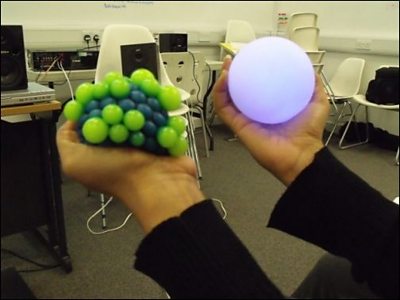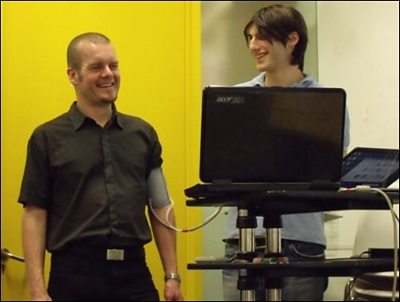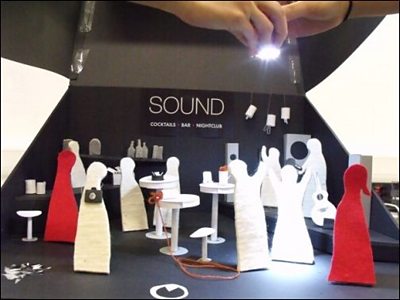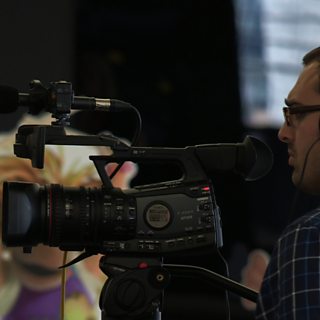On Friday 25th February Students from the in London presented their final concepts on media services for homes of the future to an audience of ±«Óătv R&D staff, tutors and students.
Since the beginning of February small groups of students from the departments of Innovation Design Engineering, Communication Art & Design and History of Design have been working on one of the following three questions under the guidance of ±«Óătv R&D staff:
- How can we re-imagine the inter-generational home through media extension into connected environments?
- How can diverse media streams encourage dialogue and enable shared experiences?
Can assistive technologies for disabled viewers be delivered in a way that complements and enhances the viewing experience of others in a shared space?

The ideas the students presented were as varied as they were impressive.
Pets
The first group's "smart-pets" idea really pushed the boundaries of how futureaudiences can expect to interact with their media. Trying to make new technology less intimidating, the group proposed building robotic pets that would act as intermediaries between people and their media preferences.
These pets would roam around the house, drawing your attention to content of interest and reminding you of media you may have missed. Such physical intermediaries between audiences and media led to some great questions about where the sweet spot lies between systems being helpful and annoying, or just plain freaky. As well as recommending media these creatures would also act as mirrors on their owners' preferences and personality. One of the most interesting questions raised was around how multiple pets in the same location might act as intermediaries between users and assist in synchronising content.

Examples of how the "smart-pets" might communicate through touch or light
Memory in the Digital Age
Group 2 showed a project on digital memories. Drawing inspiration from devices like the and working from the premise that in the future more and more of our activities will be digitally recorded (geo-tagging, timestamps etc) they wanted to remove the boundaries between different types of files such as text, image or video etc and allow users to categorise different artefacts by more natural criteria.
Examining how people naturally make connections between events and artefacts, they wanted to allow people to turn related content into a more personal memory - that photo of NYC, that concert ticket stub from Vegas and that video of the Grand Canyon are all part of somebody's trip to the states so how can all that content be presented back to them as a story?
The work touched on interesting issues around how to capture, search for, transfer and access content as well as some serious privacy concerns encountered when more than one user is storing content on the same device. That latter aspect led to some great conversations around shared memories.
The Flow Experience
The third group had spent their time looking at continuous media streams. In an age where we are constantly bombarded with different types of media it is sometimes difficult to find and select content that is of interest to us.
In an attempt to alleviate "information overload" this group attempted to create a constantly evolving stream of media that ran relatively passively in the background of a home, which users could dip in and out at will. The system would track user preferences not only by genre but also by format - you might like your news presented as a text based web page for example, while your neighbour might prefer the same story by way of video. In addition to this users would be able to personalise the stream to a particular topic, location or format - you might chose to only have content concerning the goings on in Libya presented to you for a half hour or so.
The Flow Experience could be deployed either as a stand alone device or as an application on existing hardware. It examines issues around how automated systems track, analyse and interpret individuals' habits and preferences and how the results of that analysis are presented back to them.
Kinaesthetic Media Devices
Group 4 designed a prototype haptic device that enhanced the viewing experience by supplementing audio and visual information with pressure based stimulus. The physical effects were delivered through the cuff of a blood pressure monitor and were synchronised to co-ordinate with on-screen events.
In the demonstration given viewers could feel James Bond's erratic heartbeat as he suffered a heart attack in Casino Royale. Other examples of possible deployment included feeling the impact of tackles in a game of rugby or using a steady, almost imperceptible build-up of pressure to increase the tension in horror films or thrillers.

Course tutor Ashley Hall feels the full effect of James Bond's over-exertions
Augmenting traditional media sources (audio, visual, text) with other stimuli is of interest to the ±«Óătv in providing rich services to groups with widely differing accessibility needs. Questions around how programme makers would capture and send the relevant data to audiences are obvious questions to ask of this project. The psychological effects of physical stimulus are also a very interesting area of research that could be explored further.
Sound:Scape
The final presentation demonstrated a sound manipulation system that could be used to navigate through different narratives in the same piece of content. By using a device to select and isolate different audio channels users were able to select a particular story within a scene that they wished to follow.

Demonstrating the different audio channels viewers could choose to follow
Again there are questions here about how production teams record and distribute the additional content needed for a system like this. There is also the question of what type of tools would allow production teams to create multi-stranded narratives. This is an area of great interest to ±«Óătv R&D and we'll certainly be looking harder at this project to see if it supplies any answers to our questions.
What Next?
All the ±«Óătv staff came away very impressed with the students from the RCA. Everyone involved in the project worked tremendously hard over the course of the four week module, showing the full effects of sleep deprivation on the day of the presentations….
It was great to have some fresh views on areas of interest to ±«Óătv R&D. The students often came at problems we've been working on for a while from a completely different standpoint. Sometime ±«Óătv staff can get "locked in" to their own projects and experience and struggle to see the wood for the trees. Opening out our research questions to a bunch of fresh, inquisitive minds led to a tremendous amount of enthusiasm and creativity.
Every single one of the projects produced some really exciting outputs. Over the next month we'll be looking at how to extract the best ideas from all the stuff we were shown and establish a roadmap of what happens next with them. Expect more from us in the next week or two including a short video of the highlights from the presentations and development sessions.
